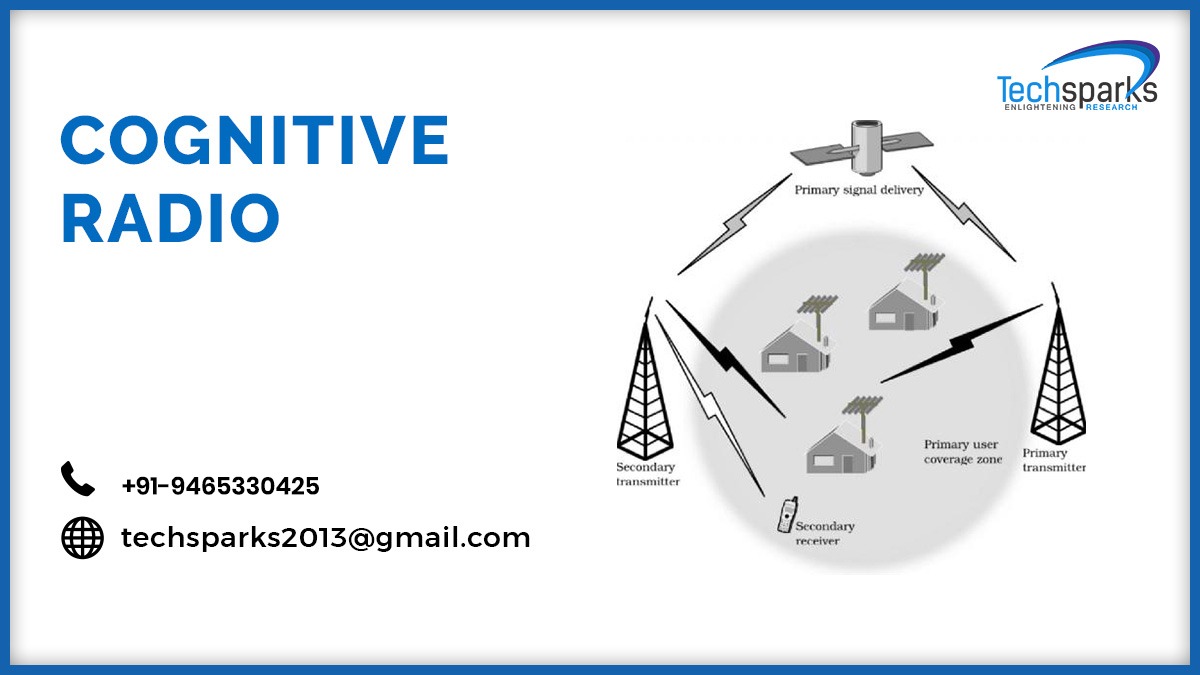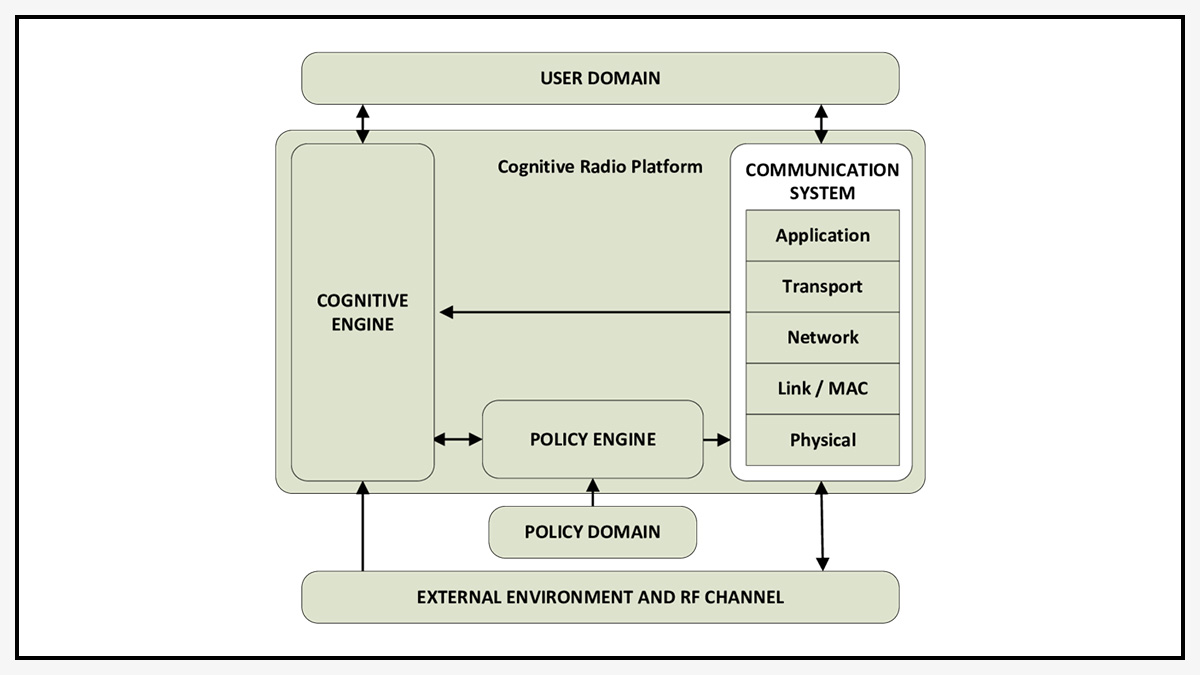What is Cognitive Radio?
Cognitive Radio is a type of wireless communication in which a device known as transceiver senses communication channels to find out which channels are vacant and which are occupied. After sensing the channels, it moves to vacant channels by avoiding occupied channels. In simple terms, a transceiver tends to use the best available wireless communication channel for communication. It uses the radio frequency spectrum with lesser interference with other. Joseph Mitola developed the idea of Cognitive Radio at the Defense Advanced Research Projects Agency(DARPA). It is a very diverse topic for an M.Tech thesis in Computer Science and Electronics and Communication. It is a very challenging topic for a thesis. There are various topics in Cognitive Radio for M.Tech and Ph.D. thesis. The main features of the cognitive radio are:
-
A transceiver can determine its geographic location.
-
It can identify and authorize its users.
-
It can perform encryption and decryption.
-
Able to sense nearby wireless devices.
-
It can adjust its output.
Types of Cognitive Radio
Depending upon certain parameters and transmission there are two types of cognitive radios:
-
Full cognitive Radio – It takes into consideration all the possible parameters that can be observed by a wireless node. It is also known as Mitola Radio.
-
Spectrum-Sensing cognitive Radio – It detects channels only in the radio frequency spectrum.
Functions of Cognitive Radio
Following are the main functions of Cognitive Radio:
-
Power Control – Power control is used so that the capacity of the secondary users is maximized along with applying certain constraints to protect the primary users.
-
Spectrum Sensing – A cognitive radio can sense empty spectrum without causing any form of interference to other users. There are three spectrum-sensing techniques:
-
Transmitter Detection
-
Energy Detection
-
Cyclo-stationary feature detection
-
Wideband Spectrum Sensing – In this the spectrum sense over large bandwidth over hundreds of MHz or even GHz.
-
Null space based Cognitive Radio – Cognitive Radio can detect null space of the primary user using multiple antennas. It can then transmit in this null space causing less interference to primary user during transmission.
-
Spectrum Management – Cognitive Radio captures the best spectrum that is available to meet the user requirements for communication.
Architecture of Cognitive Radio
While doing M.Tech thesis in Cognitive Radio you will get to know the architecture of this network. There are two subsystems of Cognitive Radio: a Cognitive Unit,
a Spectrum Sensing Subsystem
A Cognitive Unit makes decisions based on various available inputs. A flexible SDR unit provides operating modes using operating software. A spectrum sensing subsystem measures the signal in the environment and detects the presence of other users and services. This whole system is not a single equipment instead it is spread over the wide range of network.
The Cognitive Unit is further separated into two parts – Cognitive Engine and Policy Engine.
The first part ‘Cognitive Engine’ tries to find the solution and defines the radio’s current internal state and the environment in which it is operating based on the inputs. The second part ‘Policy Engine’ ensures that the solution that is provided by the first engine(Cognitive Engine) is in agreement with the rules and policies outside to radio.
Advantages of Cognitive Radio
Cognitive radio is a new concept in the area of wireless sensor network that can utilize the spectrum frequency efficiently. Cognitive radio systems have the capabilities like packet loss reduction, power waster reduction, buffer management and also better communication. Following are the advantages of cognitive radio in wireless sensor networks:
-
Efficient utilization of spectrum – The spectrum bands that are available can be used efficiently as these cannot be increased. For utilizing the radio bands in a country, a license is required from the government. This is a costly procedure. There are certain licensed spectrum bands that are underutilized and unutilized. Cognitive radio can utilize this spectrum and license holders are also not disturbed. This unutilized spectrum is known as white space.
-
More space for new technologies – New technologies can be developed for these unused bands. Cost would also be minimal when this unutilized spectrum is used by the unlicensed user.
-
Ability to utilize multiple channels – In a traditional wireless sensor network, a single channel is used for communication. In this, when an event is detected, the sensor nodes generate packets. In a dense network, sensor nodes try to occupy the single communication channel at the same time. This increases the possibility of collisions and the communication quality is decreased. Moreover, there is more power consumption and packet delay. Cognitive radio gives the opportunity to utilize multiple channels thereby reducing the chances of collision and also increases the communication quality.
-
Energy Efficiency – In traditional wireless sensor network, the power wastage is more due to increased packet retransmission due to packet loss. This energy consumption due to packet retransmission is overcome by cognitive radio.
-
Global Operability – There are certain spectrum regulation rules for each country. Each country is allotted different spectrum band which is not available in another country. Cognitive radio gives the capability to be operated in any country of the world.
-
Utilization of spectrum band that is application specific – There is an increase in wireless sensors that are deployed for different applications. The wireless sensor network generates packets when an event is triggered. The data traffic in wireless sensor network is correlated temporally and spatially which cause design challenge of the communication protocol. There are intelligent communication protocols in Cognitive radio wireless sensor network that can overcome the design challenge of protocols.
-
Financial Advantage – Those users who cannot obtain a license for spectrum due to financial problem can obtain this on lease from license holder at a low cost. This will be beneficial to both users.
-
Attacks are avoided – Cognitive radio uses a wide range of spectrum, therefore, several types of attacks can be unlike other wireless sensor network that works on a particular band of frequency.
Applications of Cognitive Radio
-
Military and Security – Cognitive Radio is used in various military and public services like chemical, biological and nuclear radiation detection, war surveillance etc. Traditional wireless sensor networks face the problem of signal jam. But this problem is no longer exist if we use cognitive radio wireless sensor network. Cognitive Radio can handoff a wide range of frequencies. It is also useful when the applications need large bandwidth.
-
Healthcare – Cognitive Radio also find its applications in the healthcare. It find its use in wearable body wireless sensors. Using this, critical data and information from patients can be acquired by doctors sitting at a distant location. These wireless sensor nodes are also reliable.
-
Home appliances – Wireless sensor network is used in certain indoor applications. But there are some challenges in those indoor applications. Cognitive Radio overcome these challenges. The examples of these applications are intelligent buildings, home monitoring system and personal entertainment.
-
Real-Time applications – In multihop wireless sensor network, there are chances of link failure which can cause delay in communication. Moreover, the nodes move to another channel if they find another channel idle. Cognitive Radio wireless sensor network increases the channel bandwidth due to which channel aggregation and use of multiple channels are possible.
-
Transportation – Cognitive Radio find its applications in transport system as well as vehicular system. A lot of research work is going on in this field with various protocols proposed for highway safety. These are also likely to be more reliable and convenient than the traditional wireless sensor network.
-
Diverse Sensing – Cognitive Radio wireless sensor network can be used in the same area but with a different motive. Cognitive Radio can use different channels for different applications using medium access protocol (MAC).
Challenges of Cognitive Radio
Cognitive Radio wireless sensor network are different from traditional wireless sensor network in certain aspects. Although they are way better than these conventional wireless sensor networks but they also face some challenges. Some of these challenges are:
-
Miss-Detection Probability and False Alarm – These are the two metrics used in cognitive radio wireless sensor network. Miss-Detection probability is a metric used in cognitive radio wireless sensor when it fails to detect the primary signal’s presence on the channel and false alarm is a metric for cognitive radio wireless sensor when it fails to detect the absence of the primary signal. These two metrics can cause problems like long waiting delay, frequent channel switching and degradation in output.
-
Hardware Issues – There are certain constraints applied on hardware of the system like computational power, storage and energy. To design an intelligent hardware for CR is a laborious task. The hardware should be such that it should be able to respond with the changes in the environment. The basic principles of cognitive radio can be fulfilled using certain artificial intelligence techniques like artificial neural network, Markov models, case-based systems etc. More or less it can be said that the design of the hardware is a very challenging issue.
-
Changes in Topology – The topologies in cognitive radio are more prone to change than the traditional wireless sensor network. This can cause hardware malfunctioning and depletion of energy. Following are the topologies employed in cognitive radio wireless network:
-
Ad Hoc
-
Clustered
-
Heterogeneous and Hierarchical
-
Mobile
-
-
Fault Tolerance – Fault Tolerance is the most challenging problem in CR-WSN.The protocols designed for cognitive radio do not have the capacity to tolerate fault. This affects the overall performance of the wireless sensor network.
-
High Manufacturing Costs – High manufacturing cost is another challenge for cognitive radio wireless network. The conventional WSN require less memory and computation than the CR-WSN. Therefore algorithms need to be designed that can lower the manufacturing cost and production.
-
Selection of Channel – In CR-WSN the channel is not fixed for sending data and for communication. This can cause non-cooperation between the nodes. This challenge can be overcome by designing some AI algorithms.
-
Power Consumption – In this network, more energy is consumed for spectrum sensing, channel selection, route discovery, transmission and reception than the traditional network. It also needs to sense the node’s activity on the channel.
-
Quality of Service – Quality of Service is a challenging issue due to certain constraints on power, memory and source. The QoS is determined by four parameters – bandwidth, delay, jitter, and reliability. Therefore an adequate level of QoS is needed to be maintained.
-
Security – CR-WSNs are also more prone to various privacy and security issues than the traditional WSNs. Attackers can attack the sensors are capture the confidential information. This data can also be destroyed by the hackers.
As earlier said it is a very challenging and innovative topic for your master’s thesis. Quite a few people know about this technology. With your M.Tech thesis, you can put forward some postulates and researches in this technology before the public. There are numerous research topics in Cognitive Radio. This blog just gave the basic overview of cognitive radio, its applications, and challenges. If you wish to choose this topic for your M.Tech or Ph.D. thesis, you can get thesis guidance and thesis help in Cognitive Radio wireless network.





Leave a Reply